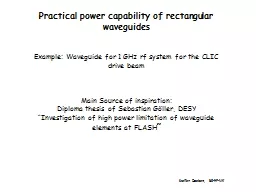

Example Waveguide for 1 GHz rf system for the CLIC drive beam Main Source of inspiration Diploma thesis of Sebastian Göller DESY Investigation of high power limitation of waveguide elements at FLASH ID: 587587
Download Presentation The PPT/PDF document "Practical power capability of rectangula..." is the property of its rightful owner. Permission is granted to download and print the materials on this web site for personal, non-commercial use only, and to display it on your personal computer provided you do not modify the materials and that you retain all copyright notices contained in the materials. By downloading content from our website, you accept the terms of this agreement.
Slide1
Practical power capability of rectangular waveguidesExample: Waveguide for 1 GHz rf system for the CLIC drive beamMain Source of inspiration:Diploma thesis of Sebastian Göller, DESY“Investigation of high power limitation of waveguide elements at FLASH”
Steffen Doebert, BE-RF-MKSlide2
Requirements for the 1 GHz rf system for the CLIC drive beamGeneral specifications:Frequency: 999.5 MHz +/- 50 MHzMax. Power: 20 MW, 150 ms, 50 Hz
VSWR: 1.15:1 max
Waveguide: WR-975, Aluminum
Environment: 2-3 bar Nitrogen
Flange: rectangular flat (parker seal)
WR975: a= 247.65 mm, b =123.8 mm,
l
= 299.79 mm,
l
c
= 495.9 mm,
Zo
= 377
WSlide3
Theoretical cw power limit for waveguidesBreakdown voltage in air: 30 kV/cm = 3 MV/m
P
theo
(WR975) = 145 MWSlide4
Theoretical cw power limit for waveguidesSlide5
Theoretical attenuation for waveguidesSlide6
Additional influencing factorsAverage power:(mainly through heating, see temperature)Pulse length: (pulse length, rep rate dependence)Waveguide pressure: (higher is better)Humidity: (wet is better)
Gas species: (air
vs
SF
6
)
VSWR=
Vmax
/
Vmin
=(
V
f
+V
r
)/(
V
f
-V
r
), short circuit
P
max
/4
E
max
= E
0
{2*VSWR/(VSWR+1)}
2
Geometrical field enhancement: waveguide components, HOM’s
Temperature: (hot is worse)
Thesis at DESY based on field emission and experiments !Slide7
Theoretical cw power limit for waveguides for different gases and pressureIonization rate vs other electron loss mechanisms
Temperature dependence: p= N/V
k
b
T
(for constant p, density goes down with higher T)Slide8
Theoretical cw power limit for waveguides for different gases and pressureSlide9
Humidity(water vapour has a electronegative effect)Quite difficult in practice to control, other effects condensation, rustSlide10
Roughness or FN-betaConclusion typical beta ~ 2Slide11
Geometrical field enhancementHigher Order Modes could as well contribute(Study concludes not an issue for DESY parameters)Slide12
Experimental set up to verify assumptionsSlide13
Pulse length and rep rate dependenceDESY decided to treat their case as cwSlide14
Practical power limit as suggested by DESYf: field enhancement (1= straight, 1.5 E-bend, 2 bellows)b: FN-beta (typically 2 in waveguides)h: humidity (h=1)
p
: absolute pressure in bars
T: temperature (important for high average power)
VSWR: voltage standing wave ratio (typical value of components 1.2)
Therefore with typical values: P =
P
theo
*0.093
For WR650:
P
theo
= 58 MW,
P
practical
= 5.4 MW in good agreement with experiments and experienceSlide15
Predicted power limits for the 1 GHz systemP theo (WR975) = 145 MWP practical = 145 *0.093 = 13.5 MW
P (2 bar) = 34 MW
P (3 bar) = 58 MW
Keep in mind this assumes CW operation
(factor 1.5-2 according to DESY assumptions)
Mega Industries typical specs:
P
max
/min
(MW)Slide16
ConclusionWith 2 bars dry air and carefully chosen waveguide components,20 MW peak power should be save to operateAdditional safety margin can come from using higher pressure or SF6 if neededStatus of the L-band klystron:
Call for tender preparation:
Parameters, 20 MW, 150
m
s
, 50 Hz, ~70% efficiencySlide17
News from CTF3Detailed talk by Robert during the next project meeting, 24th of MayTBL operation with up to 21 A, 720 MW total, 40 MeV deceleration average (33%, peak close to 40%)TBTS, not much time yet with factor 8, Thursday and FridayRecheck wake field monitors at higher power, some noise
BPM’s, CLIC prototype BPMs for main beam and drive beam successfully tested, behaviour as expected
Successful tests of phase monitors for phase feed forwardSlide18
News from CTF3Slide19
News from CTF3Slide20
News from CTF3